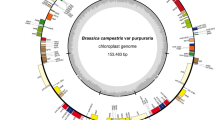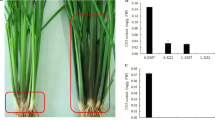Abstract
The polymerase chain reaction (PCR) was used to produce 3 putative clones for ACC synthase from etiolated mung bean (Vigna radiata Rwilcz cv. Berken) hypocotyls. This was accomplished by utilizing genomic DNA from mung bean and degenerate primers made from information derived from highly conserved regions of ACC synthase from different plant tissues. The total length of pMAC-1, pMAC-2 and pMAC-3 are 308, 321, and 326 bp, respectively, all of which code for 68 amino acids. The introns for pMAC-1, pMAC-2 and pMAC-3 are 92, 105, and 110 bp, respectively. The degrees of homology at the DNA level for each of these clones is ca. 80% in their coding region and ca. 50% in their respective introns. This is the first report providing evidence that there are at least 3 genes for ACC synthase in etiolated mung bean.
Similar content being viewed by others
References
Abeles FB: Ethylene in Plant Biology. Academic Press, New York (1973).
Dong JG, Kim WT, Yip WK, Thompson GA, Li L, Bennett AB, Yang SF: Cloning of a cDNA encoding 1-aminocyclopropane-1-carboxylate synthase and expression of its mRNA in ripening apple fruit. Planta 185: 38–45 (1991).
Huang P-L, Parks JE, Rottmann WH, Theologis A: Two genes encoding 1-aminocyclopropane-1-carboxylate synthase in zucchini (Cucurbita pepo) are clustered and similar but differentially regulated. Proc Natl Acad Sci USA 88: 7021–7025 (1991).
Nakajima N, Mori Y, Yamazaki K, Imaseki H: Molecular cloning and sequence of a complementary DNA encoding 1-aminocyclopropane-1-carboxylate synthase induced by tissue wounding. Plant Cell Physiol 31: 1021–1029 (1990).
Olson DC, White JA, Edelman L, Harkins RN, Kende H: Differential expression of two genes for 1-aminocyclopropane-1-carboxylate synthase in tomato fruits. Proc Natl Acad Sci USA 88: 5340–5344 (1991).
Sambrook J, Fritsch EF, Maniatis T: Molecular Cloning: A Laboratory Manual. Cold Spring Harbor Laboratory, Cold Spring Harbor, NY (1989).
Sanger F, Nicklen S, Coulson AR: DNA sequencing with chain-terminating inhibitors. Proc Natl Acad Sci USA 74: 5463–5467 (1977).
Sato T, Oeller PW, Theologis A: The 1-aminocyclopropane-1-carboxylate synthase ofCucurbita: Purification, properties, expression inEscherichia coli, and primary structure determination by DNA sequence analysis. J Biol Chem 266: 3752–3759 (1991).
Van derStraeten D, vanWiemeersch L, Goodman HM, vanMontagu M: Cloning and sequence of two different cDNAs encoding 1-aminocyclopropane-1-carboxylate synthase in tomato. Proc Natl Acad Sci USA 87: 4859–4863 (1990).
Yip WK, Dong JG, Yang SF: Purification and characterization of 1-aminocyclopropane-1-carboxylate synthase from apple fruits. Plant Physiol 95: 251–257 (1991).
Author information
Authors and Affiliations
Rights and permissions
About this article
Cite this article
Botella, J.R., Schlagnhaufer, C.D., Arteca, R.N. et al. Identification and characterization of three putative genes for 1-aminocyclopropane-1-carboxylate synthase from etiolated mung bean hypocotyl segments. Plant Mol Biol 18, 793–797 (1992). https://doi.org/10.1007/BF00020022
Received:
Accepted:
Issue Date:
DOI: https://doi.org/10.1007/BF00020022




